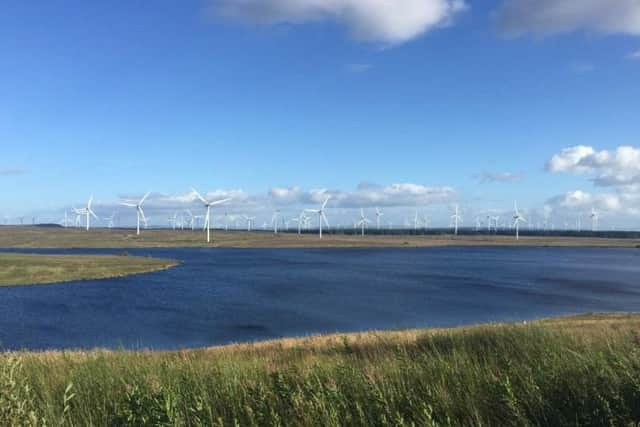Sustainable Scotland: What renewable energy 'superpower' will help Scotland hit climate target?
The Scottish net zero target is five years ahead of the rest of the UK (and much of the world), but experts told The Scotsman’s Sustainable Scotland podcast it can be done - but it won’t be easy.
“Scotland can do it, it must do it. But experience to date has been that we’re falling short of our targets,” says Richard Cockburn, partner and UK head of energy at legal firm Womble Bond Dickinson.
He said Scotland’s “net zero scorecard” in 2021 showed it was only hitting 9 of 30 targets.


Unlocking the full potential
Reaching the 2045 target, he says, means unlocking the full potential of hydrogen, carbon capture and storage and all forms of renewable energy - with offshore wind having the greatest potential.
Joanne Allday, Strategic Business Development manager at Port of Cromarty Firth, tells the podcast: “Offshore wind is, if you like, our country’s renewable superpower” - and says the real opportunity for Scotland is to grasp the opportunity presented by floating wind and become a world leader in that field.
The announcement (in January 2022) of plans for up to 25 Gigawatts (GW) of new offshore wind power in Scottish waters was an “incredible statement of intent to put Scotland on the offshore wind map”, Allday says.
The announcement went much further than expected as Scotland currently has around 2GW of offshore wind power and a target of 11GW by 2030.
Estimates suggest for each 1GW of offshore wind power installed, around £1 billion will be invested in the Scottish economy.
Richard Cockburn says the offshore wind announcement was very significant in environmental and economic terms - especially as the sites, and therefore potential benefits, were spread around Scotland.
However, he warns that the number of jobs coming from Scotland’s shift to a low-carbon economy didn’t yet come near the employment levels in the declining oil and gas industry.
Job creation
“There’s a mismatch just now,” says Cockburn. “In the oil and gas industry in Scotland, there are [still] about 110,000 jobs. In the Scottish renewable sector, it’s around the 25,000 mark. Straight away, you can see the big difference between the two.”
He continues: “The Scottish Government has a target of getting to 130,000 renewable energy jobs. We’re not anywhere near that [but] there’s a lot of work going on - including the Energy Skills Alliances Scotland, a collection of organisations looking at how to transition oil and gas workers into renewables. And we’ve got the North Sea transition deal, between government and industry, to try and get the North Sea oil and gas industry properly transitioned, with an express aim to create around 40,000 new low carbon jobs. We’re getting there, but there’s a long way to go.”
Ronnie Quinn, Chief Executive of NECCUS, a consortium working to decarbonise Scotland’s heavy industry, says carbon capture and storage (CCS) is essential to creating jobs and meeting Scotland’s 2045 net zero target.
“We need carbon capture and storage to decarbonise our industry, keep the economy going, keep jobs in place, and contribute by keeping that CO2 out of the atmosphere at source,” he says. “It’s not a question of if this will happen. It’s just a question of how soon.”
Quinn says CCS can initially take about 5 million tonnes of CO2 and store it under the North Sea - growing within a decade to about 9 million tonnes
He adds: “Economically there will be opportunities, with what people are calling first mover advantage, to build up that supply chain in Scotland and optimise the benefits.”
Hydrogen potential
The podcast also discusses the huge potential of hydrogen as an energy source - for larger forms of transport, heating, industrial power and much more.
“Hydrogen is a really exciting option as part of the net zero mix - it’s readily available and we have the technology to produce it,” says Richard Cockburn.
However, creating “green hydrogen” (effectively by splitting water using renewable energy) is still very expensive, Cockburn says, although recent research suggests costs are now coming down more quickly than expected.
Another expensive area is decarbonising heat - with the bill for reducing emissions from domestic and non-domestic buildings by 2045 thought to be in excess of £30 billion, as well as electrifying the transport network.
These are two enormous areas affecting people’s lives where additional investment, new technology - and creative, collaborative solutions - will be needed, says Cockburn.
So can Scotland make it by 2045?
“It’s achievable - and that’s the important thing,” says Ronnie Quinn. “It’s not going to be easy and to suggest that it is I think would be wrong, but it is achievable if we start now.”
Richard Cockburn agrees: “It’s definitely within our power to do it [but] we need to pull our socks up to get there.
“Is it likely? There’s a lot of good stuff going on in offshore wind, hydrogen, carbon capture, onshore wind solar, you name it. So yes, I’m confident that we will get there.”
A message from the Editor:
Thank you for reading this article. We're more reliant on your support than ever as the shift in consumer habits brought about by Coronavirus impacts our advertisers.
If you haven't already, please consider supporting our trusted, fact-checked journalism by taking out a digital subscription.